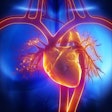Its true clinical significance is unknown, but the presence of significant hepatic fat deposits (≥ 30%) may be associated with both cardiovascular disease and the progression of liver diseases such as steatohepatitis, fibrosis, and cirrhosis.
In any case, you probably don't want to see it in your liver donor candidates. Dr. Perry Pickhardt and colleagues examined 276 potential liver donors who underwent same-day noncontrast CT and an ultrasound-guided liver biopsy. The group measured attenuation at several points in the organ and evaluated the effect of patient age, gender, hepatic iron grade, and specific CT scanner vendor on attenuation.
The attenuation threshold of 47 HU or lower produced a whopping 100% specificity (276/276) for detecting moderate-to-severe steatosis (≥ 30% fat at histology), Pickhardt and colleagues will report. Sensitivity at that HU level was 53.8%, and the positive and negative predictive values were 100% and 93%, respectively.
Noncontrast CT liver attenuation is 100% specific for detecting moderate or severe degrees of hepatic steatosis, and it can confidently identify severe fatty liver without the need for biopsy, they concluded.
"The fact that this approach is highly specific allows us to retrospectively identify cases at CT (e.g., 10 years ago) without risk of false positives, and then perform follow-up to see if these patients are at higher risk for developing cirrhosis, cardiovascular disease, etc.," Pickhardt told AuntMinnie.com.



















